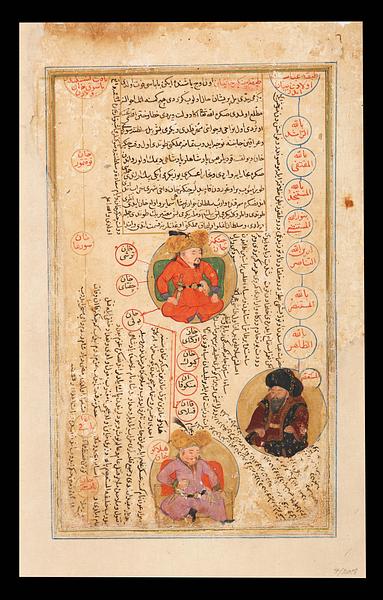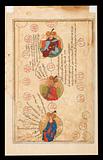A
Silsilename (from Arabic
silsila, chain) is a genealogy of the Ottoman sultans. It may also include the family trees of earlier Islamic and pre-Islamic dynasties, as well as those of the biblical prophets. This type of work was popular, and several updated versions were produced between the sixteenth and nineteenth centuries.
The top portrait on the front of the leaf depicts Genghis Khan (d. 1227). The names of his sons follow, and at the bottom is a portrait of his grandson, Hülegü Khan (d. 1265). On the right is the row of Abbasid caliphs ending with a portrait of al-Mustasim, who was killed during Hülegü’s conquest of Baghdad in 1258.
The back of the leaf presents Hülegü’s descendants, the Il-Khanids, who ruled Iraq and Iran until approximately 1350. The figures portrayed are Abaqa Khan (d. 1280), Arghun Khan (d. 1291) and Baydu Khan (d. 1295).
Genghis Khan and his descendants are depicted sitting in the classic manner of Mongol rulers, legs crossed and leaning against large cushions. Both Genghis and Hülegü carry a white scarf (
mandil) in their belt – a frequently used symbol of power in portraits of Mongol and Turkish princes (
30/1995).
The Ottomans’ own ancestors are presented in a modest, unillustrated family tree on the far left. Later in the manuscript, however, the Ottomans take centre stage. The last three leaves, now owned by the Linden Museum in Stuttgart, contain portraits of the Ottoman sultans only, concluding with an equestrian portrait of Sultan Ahmad I (r. 1603–17).
[1] The Ottomans are thus presented as the natural heirs of the Il-Khanids and other great dynasties of the past, while their regional competitors, such as the Safavids in Iran, are ignored.
The manuscript from which the leaf originates was probably made in Baghdad, as was at least five other preserved
Silsilename manuscripts from around the year 1600.
[2] The portrait of Sultan Mustafa III (
36/1977) comes from a later
Silsilename made in the second half of the eighteenth century.


